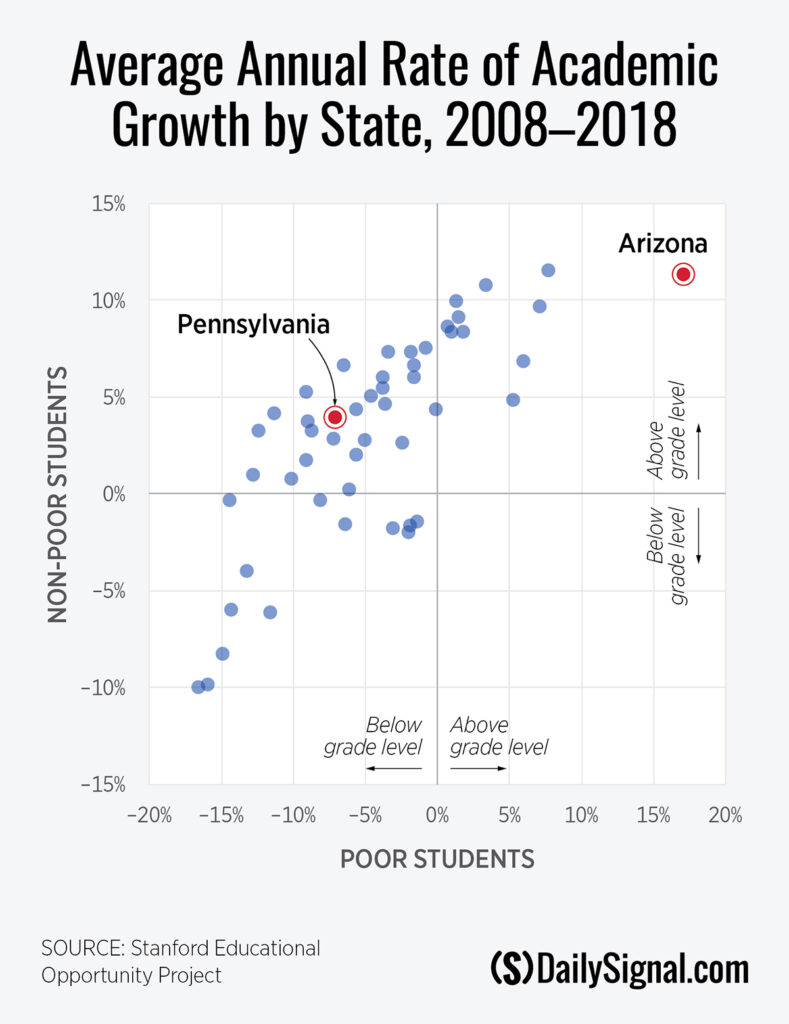Touchdown Arizona!
Philanthropist Janine Yass penned a column recently that was so delightfully perfect about the importance of school choice and how we as a country seem to be more engaged in football scores than test scores that I can kick myself for not having written it myself. She referenced an NFL upset victory of the lowly Arizona Cardinals over the more formidable Philadelphia Eagles earlier this season. Here’s an excerpt:
The Eagles’ embarrassing loss to the Cardinals on New Year’s Eve day, resulting in their ceding the NFC’s top seed to Dallas have fans beside themselves. The media is all over the ‘why,’ including retrospectives on whether the season is all over before the playoffs even start.
What happened, what went wrong, how do we fix it, who’s to blame? Fire the coach! Change the plays!! Local radio, newspapers, and TV are consumed by it all. The attention, concern, and outrage is unrelenting and expectations shattered.
Sports are front page news—win, lose, or draw, but especially when they disappoint. How I wish there was as much attention to the challenges students face daily throughout U.S. public school systems that haven’t won a single game for the home team for almost 40 years. Don’t get me wrong. I love football. It’s great sport and hobby to millions, but it’s hardly as consequential as education.
When your favorite team begins to fail, they change the plays, or the people. Not in traditional education. When public school actions or inaction result in failure for a majority of students, there’s little done. Those who are the first to publicize a team’s shortcomings barely take notice when students fail. There’s no demand for changing the plays, or the managers, school leaders, policymakers, and those delivering the actual education.
As Yass correctly notes, K-12 education outcomes are far more important than sports. If Pennsylvanians were disappointed with the Cardinals beating the Eagles, they should brace themselves for a much greater Arizona upset victory: Arizona is doing a much better job promoting students’ academic growth, including with its poorest students, far outpacing Pennsylvania.
Scholars at the Stanford Educational Opportunity Project linked state testing data in grades 3-8 from across the country for the 2008-2018 period. Project scholars were able to calculate average rates of academic growth by state for this period.
Scholars and analysts widely regard academic growth as the best measure of school quality. Academic proficiency—how well students have mastered specific subject matter—is highly correlated with student demographics (wealthy students score higher on average than low-income students, for example). Academic growth, however, measures how much students learn per year of schooling and is not nearly as strongly correlated with student demographics.
The graph below shows the average rate of academic growth for low-income students (horizontal axis) and for middle/high-income students (vertical axis) by state. In both cases, zero percent equates to “learned one grade level per year” on average for the 2008-2018 period in reading and math. Numbers below the zero line mean students are learning less than a year’s worth of academic material each year.

As you can see from the graph, Arizona beat Pennsylvania on these measures, which are far more consequential than an NFL scoreboard. Pennsylvania had an average rate of academic growth for low-income students that was 7% below learning a grade level per year for the period. Pennsylvania’s middle- and high-income students averaged a bit more than a grade level of progress per year—4% higher per year on average.
The slower rate of academic growth for low-income Pennsylvania students represents a growing achievement gap and adding to it year by year. In other words, annually, economically advantaged students pulled a bit further ahead, and every year, low-income Pennsylvania students fell further behind.
Arizona’s low-income students learned at an average rate 17% above learning one grade level per year, and the Grand Canyon state’s non-poor students also ranked among the highest states, at 11% above. While Pennsylvania saw a steadily growing achievement gap between poor and non-poor students, Arizona made progress in closing the gap with a nation-leading rate of growth for low-income students.
We cannot be sure exactly why Arizona’s students led the nation in academic growth during this period, but the amount of K-12 school choice in the state stands out. Arizona lawmakers passed the nation’s strongest charter school statute and a statewide district open enrollment statute (allowing students to enroll in any public school district of their choice) in 1994.
They also created the nation’s first scholarship tax credit program in 1997, which funded school choice for students by giving tax incentives to people who donated to school choice scholarships. Lawmakers have expanded the credit several times since 1997 to include more students. In 2011, Arizona lawmakers created the nation’s first education savings account program, where public funds are deposited into accounts for families to use to fund private-school tuition, online learning, or homeschooling costs. Lawmakers expanded the eligibility for this program to all Arizona students in 2022.
Contrary to the claims of school choice opponents, Arizona’s public school districts are alive and performing well. District schools both gain and lose students through choice programs, but district open enrollment remains the largest form of choice despite the growth of private choice and Arizona having the largest charter school sector (22% of students) in the country.
The variety and pluralism in school types available to families represent the secret to success in Arizona schooling. One size of cleats would fit few football players. Likewise, a standardized and homogenized set of schools fits the needs of few students. In the Phoenix area, for example, most K-8 students do not attend their zoned district school, opting instead for a wide array of other district, charter, private, online, and homeschool options, and both public and private micro-schools.
Pennsylvania lawmakers have adopted a number of policies to expand schooling options, and they should think bigger and take action that is bolder, like Arizona has done. And Pennsylvania families, voting with their feet, should be able to decide which schools they value and which they do not.
Have an opinion about this article? To sound off, please email letters@DailySignal.com, and we’ll consider publishing your edited remarks in our regular “We Hear You” feature. Remember to include the URL or headline of the article plus your name and town and/or state.

























